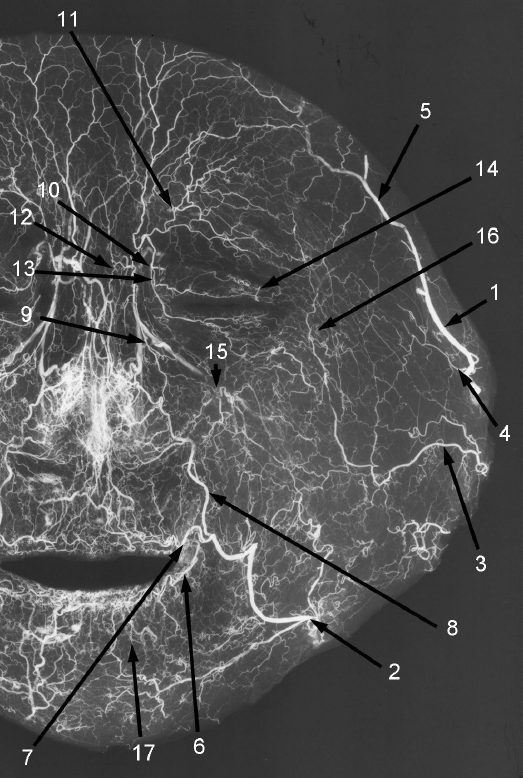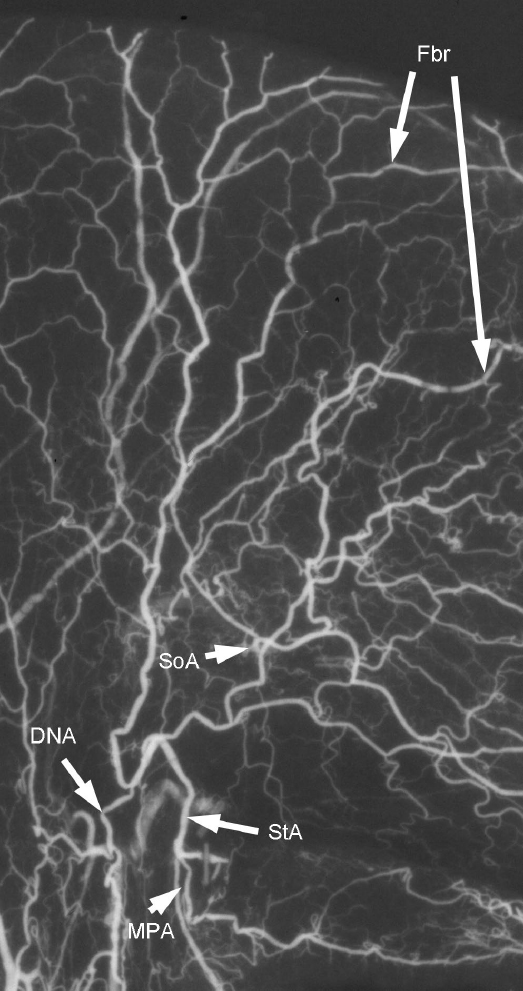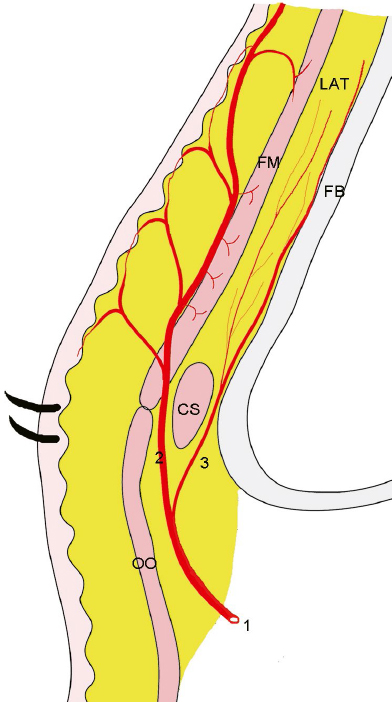Introduction
Arterial supply of the facial skin is chiefly provided by the facial and superficial temporal arteries and also by branches of the maxillary and ophthalmic arteries, which accompany the cutaneous branches of the trigeminal nerve. Branches from the source arteries run within the subcutaneous soft tissue and reach the dermis and then form the subdermal plexus. In this chapter, the detailed arterial vascularity of each region of the face on the basis of angiograms I have performed is described. Because the arterial supply of the face is substantial, necrosis of most local flaps here rarely occurs; however, knowledge of the arterial anatomy of the face is important when various local flaps of the face are elevated.
Arteries of the Facial Skin
The superficial temporal, facial, and ophthalmic arteries are three major source arteries of the facial skin. The superficial temporal artery gives off the transverse facial and zygomaticoorbital arteries and divides into the frontal and parietal branches. The facial artery gives off the submental, inferior labial, superior labial, and lateral nasal arteries and then becomes the angular artery. The ophthalmic artery gives off the supratrochlear, supraorbital, dorsal nasal, and medial and lateral palpebral arteries. The branches from the source arteries form an intimate vascular network in the face (Fig. 5.1). In addition, the infraorbital, zygomaticofacial, and mental arteries, which are derived from the maxillary artery, accompany cutaneous branches of the trigeminal nerve. The skin territories supplied by the zygomaticofacial and mental arteries are small and play only a supplemental role in the blood supply of the face.
Vasculature of Each Region of the Face
Forehead
Blood supply to the forehead is provided by the supratrochlear and supraorbital arteries and the frontal branch of the superficial temporal artery (Fig. 5.2). An intimate vascular plexus is formed by the arteries and their branches. The supratrochlear artery is dominant in the median forehead. The main trunk of the artery penetrates the orbital septum above the medial palpebral ligament and then ascends between the corrugator supercilii and orbicularis oculi muscles after sending vessels to the loose areolar tissue under the corrugator supercilii muscle.1,2 It penetrates the frontalis muscle about 1 cm above the eyebrow and runs approximately a few centimeters just above the muscle to reach the subdermal plane (Fig. 5.3). During its course, small vessels branch off toward the dermis and frontalis muscle. The supratrochlear artery does not travel far into the frontalis muscle. The forehead flap originally included the frontalis muscle, but from the point of view of arterial anatomy, it is not essential to include the muscle itself. Therefore, the forehead flap is not a musculocutaneous flap but rather a fasciocutaneous flap.
Upper Eyelid
Blood supply of the upper eyelid is provided by four arterial arcades—the marginal, peripheral, superficial orbital, and deep orbital arcades—and by ascending and descending branches from these arcades3 (Fig. 5.4, Fig. 5.5). Among these arcades, the marginal one along the margin of the upper eyelid and the peripheral one along the upper margin of the tarsus are formed by vascular anastomoses of medial and lateral palpebral arteries from the ophthalmic artery.
The marginal arcade runs along the front lower edge of the tarsus, giving off branches that ascend on the anterior and posterior surfaces of the orbicularis oculi muscle and tarsus. Among these ascending branches, the arteries on the anterior surface of the orbicularis oculi muscle and on the posterior surface of the tarsus pass under the lower margin of the muscle and tarsus. From the ascending branches, additional small vessels reach the skin, orbicularis oculi muscles, and tarsus. The margin of the eyelid is also supplied by small direct vessels from the marginal arcade.
The peripheral arcade runs along the attachment of Müller’s muscle to the tarsus, giving off branches that descend on the anterior and posterior surfaces of the tarsus. These descending branches communicate with the ascending branches from the marginal arcade.
The superficial and deep orbital arcades run on the anterior and posterior surfaces of the orbicularis oculi muscle along the superior margin of the orbit. The main blood supply of the arcades is provided by the supratrochlear artery. The supraorbital and medial palpebral arteries on the medial side of the orbit and the zygomatico-orbital, transverse facial, and superficial temporal arteries on the lateral side participate in forming the superficial and deep orbital arcades. Descending vessels from the superficial orbital arcade on the anterior surface of the orbicularis oculi muscle and from the deep orbital arcade on the posterior of the muscle anastomose with the ascending branches of the marginal arcade.
Fig. 5.1 Angiogram of the face. (1) Superficial temporal artery. (2) Facial artery. (3) Transverse facial artery. (4) Zygomatico-orbital artery. (5) Frontal branch. (6) Inferior labial artery. (7) Superior labial artery. (8) Lateral nasal artery. (9) Angular artery. (10) Supratrochlear artery. (11) Supraorbital artery. (12) Dorsal nasal artery. (13) Medial palpebral artery. (14) Lateral palpebral artery. (15) Infraorbital artery. (16) Zygomaticofacial artery. (17) Mental artery.
Fig. 5.2 Angiogram of the left forehead. Enlarged image of Fig. 5.1. DNA, dorsal palpebral artery; Fbr, frontal branch of the superficial temporal artery; MPA, medial palpebral artery; SoA, supraorbital artery; StA, supratrochlear artery.
Because the blood supply to the skin depends basically on the superficial orbital and marginal arcades and their connecting vessels, it is necessary for a local flap on the upper eyelid to be elevated just above the orbicularis oculi muscle, thereby preserving those vessels. There are no major arteries within the orbicularis oculi muscle, and blood supply of the muscle is provided by small branches from the ascending and descending vessels on the anterior and posterior surfaces of the muscle. In the case of a musculocutaneous flap, such as a V–Y advancement flap, its blood supply depends on the deep orbital and marginal arcades and their connecting vessels. Accordingly, surgical operations must not extend behind the orbicularis oculi muscle.
< div class='tao-gold-member'>
Stay updated, free articles. Join our Telegram channel

Full access? Get Clinical Tree











